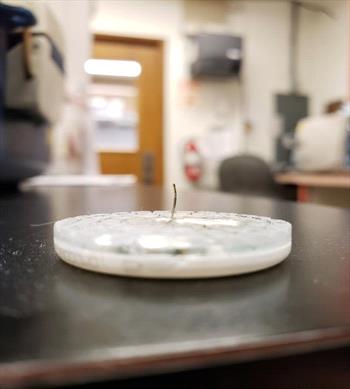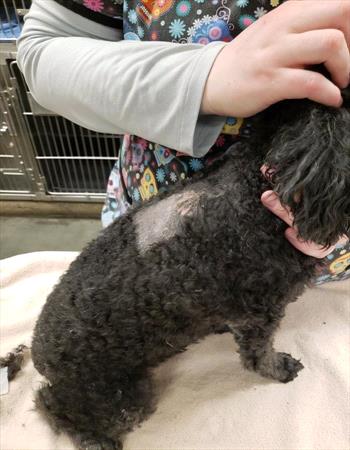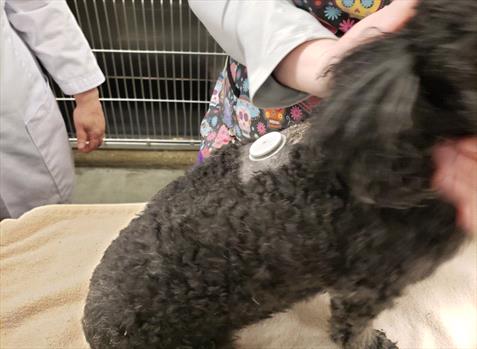Margaret Hammond-Lenzer, DVM; Sherri Wilson, DVM, DACVIM; Brett Wasik, DVM, DACVIM
The flash glucose monitoring system (also called continuous glucose monitoring or CGM) is a faster, easier, and less painful way for you to monitor your diabetic pet’s glucose levels at home. There are several flash glucose monitoring systems on the market, of which FreeStyle Libre is one. The following information is only referencing the FreeStyle Libre, as that is the only system with which veterinarians have experience to date, and the only system with a published study in dogs. Unfortunately, however, the company (Abbott) does not provide support for veterinary use (e.g. it is not approved in animals, and they do not answer questions about animal use on their support line nor do they replace the Sensor should it prematurely detach from an animal or fail to work on an animal).
A flash monitoring system allows you to monitor your pet’s glucose levels at home without pricking foot pads, ears, or lips to collect blood which means that more frequent readings can be taken without additional stress for you or your pet.
Flash glucose monitoring systems measure the glucose in the fluid that is present in the tissues under the skin (interstitial fluid glucose). There is a small difference in this measurement as compared to the amount of glucose in the blood, but for the purpose of monitoring your pet’s diabetes that difference is negligible.
How it Works
A sensor with a tiny, flexible sampling catheter (tube) is implanted in your pet’s skin. The sampling catheter is linked to a glucose analyzer that has a wireless link to a reader similar to a grocery store bar code reader. The reader can sense the glucose level when it is within a few feet of the sensor, but active readings (passing the reader over the sensor) should be taken at intervals recommended by your veterinarian. The sensor should be actively scanned at least every 8 hours to maximize the data capture within that 24-hour period. Instead of the Reader, an iPhone app can be used as the reader if the owner has an iPhone 7 (or newer). Only one iPhone should be used as the Reader, as there will be big gaps in the data if two iPhones in the house are used.
The sensor is about the size of a quarter and about as thick as two stacked quarters.
Sensor with Sampling Catheter

Photo by Dr. Margaret Hammond-Lenzer
How the Sensor is Implanted
Implanting the sensor should be done by your veterinarian. Implanting the sensor takes only seconds and is less painful than a vaccination. Most pets don’t even notice when the sensor is implanted.
A small area on your pet’s back is shaved, the area is cleaned, and the sensor, which comes with its own implantation device, is pressed into the skin.
Ready for Implantation

Photo by Dr. Margaret Hammond-Lenzer
Sensor Implanted

Photo by Dr. Margaret Hammond-Lenzer
Where do I Get One?
Your veterinarian will write a prescription for the sensor. Each sensor is only used once and will generate 14 days of continuous glucose data. You will need to purchase a new sensor any time your veterinarian recommends repeating the glucose monitoring.
Since animals have their own ideas, many pets manage to dislodge the sensor before the 14-day expiration. Don’t despair, on average your veterinarian can get several days of data which can still provide accurate information to manage your dog or cat’s blood glucose concentrations appropriately. Even a day or two of data is no more expensive than a single daylong curve in a vet hospital and the sensor data shows the glucose levels when the pet is not stressed, which is invaluable, especially in cats.
The reader should last for 3 years if you take care of it. A charging cord is supplied in the reader kit.
How Can I Increase the Odds of Keeping the Sensor On?
Your veterinarian will attempt to find the best area for your pet's sensor placement. A flat area that doesn't move much, isn't within one inch of where the insulin is injected, and that the pet's mouth and back feet can't reach is needed. The ideal area may be different for each pet, especially cats. Some cats leave it more alone if they are wearing a ‘T-shirt’, such as a piece of orthopedic stockinette that has holes cut in it for their legs. You could put an Elizabethan collar on the pet so they can’t turn around and bite it out, then just concentrate on putting it in a place where their back legs don’t easily reach to scratch it off.
How do I Interpret the Information?
Your veterinarian will work with you to make sure you can upload the data from the reader to your computer and send it to the veterinary hospital for review. Because the sensor lasts 14 days, your veterinarian can usually change the insulin dose 1-2 times (if necessary) while the sensor is still working and evaluate the results of that change.
This means you and your veterinarian need to figure out how data will be sent to them BEFORE the Sensor is activated, so you can take full advantage of the data.
Important Information about Hypoglycemia
The flash systems are sometimes not as consistently reliable for pets as they are for humans.
If the flash system indicates that your pet’s glucose level is low and your pet isn’t having signs of low blood glucose (trembling, weakness, panting, seizures, collapse etc.) you should check your pet’s blood glucose with a standard veterinary glucometer before offering any snacks to counteract the hypoglycemia.
If your pet is having signs of hypoglycemia and the flash system is registering a normal glucose level you should also double check the flash system against a standard glucometer.
Flash glucose monitoring systems are a big step forward in managing diabetes in our pets. With these systems your veterinarian has vital information that can help them craft a treatment protocol that exactly fits your pet’s metabolic needs.